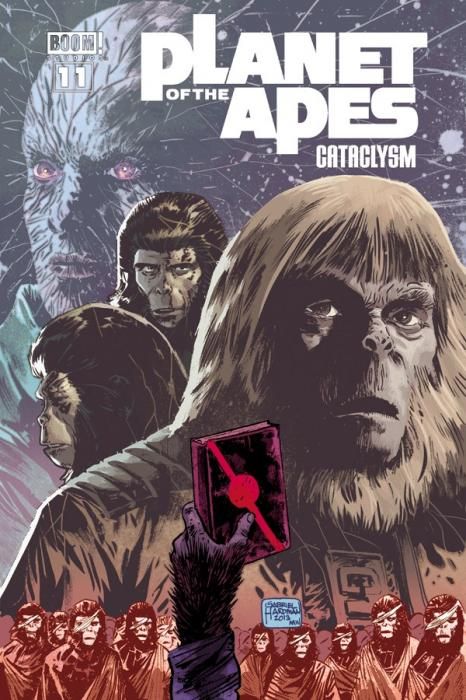Writing team Corinna Bechko and Gabriel Hardman bring the series to its penultimate issue, along with the regular artist team of Damian Couceiro and Mariano Taibo. And "Planet of the Apes: Cataclysm" #11 is a bittersweet almost-farewell, as this issue typifies the excellent writing that has spanned this bridge series between BOOM! Studios' previous ongoing title and the very first Apes film.
With the series nearing its end, the transition from the resurgent, almost Victorian-esque Ape City from the ongoing series to a bleaker and more primitive incarnation is nearly complete, thanks to the fallout from the lunar calamity that took place in past issues. Couceiro and Taibo's art doesn't have that detailed, polished look that Carlos Magno's did, but it's a style better suited to a locale that's recently seen and continues to suffer from disaster strike. It's a raw, gritty look that aligns itself well with the barren and post-apocalyptic world seen in the original 1968 movie. It's not pretty, but then, it really shouldn't be.
An attempted chimpanzee coupe to overthrow the rule of Doctor Zaius is an excellent device by Bechko and Hardman to showcase the social unrest that plagues the city. The caste system of the original film (orangutans hold most of the power, chimpanzees are the thinkers, and gorillas are little more than muscle) has yet to stabilize in this series, so the events of this issue yield some genuine and interesting surprises regarding the gorilla army and the chimpanzees' brazen actions. Unlike the first film, where pretty much all individual apes within the same species generally acted and thought the same way, there's no such homogenous behavior here. There is disagreement and dissent amongst different factions and characters, and even knowing that events will play out in a way to lead into the movies, the writing team still manages to generate tension and excitement as happenings from this issue and the series near their climax. There's an especially surprising ending to this issue probably few apes fans would see coming.
The writers also have ears for good, tightly written dialogue; casual conversation flows easily without sounding mundane, tense exchanges don't overdo the drama, and one climactic scene easily could have been scripted with sappy melodrama, but wisely was not. Words are treated fine candies; they are rationed carefully. There are no lengthy exchanges or diatribes; the characters say what they have to say, and the story moves on.
All creators involved with this issue and this series are very good at what they do, without trying to blind or distract readers with undue flash and pizzazz. They are especially adept at working so well within the confines of an existing franchise, especially one that's been mishandled in the past; all while being sandwiched between a pre-determined starting and finishing point. They even expand upon it with some surprising touches and a deeper look at some of the themes mentioned or touched on in the films. This storytelling in this issue makes "Planet of the Apes" a better place.

